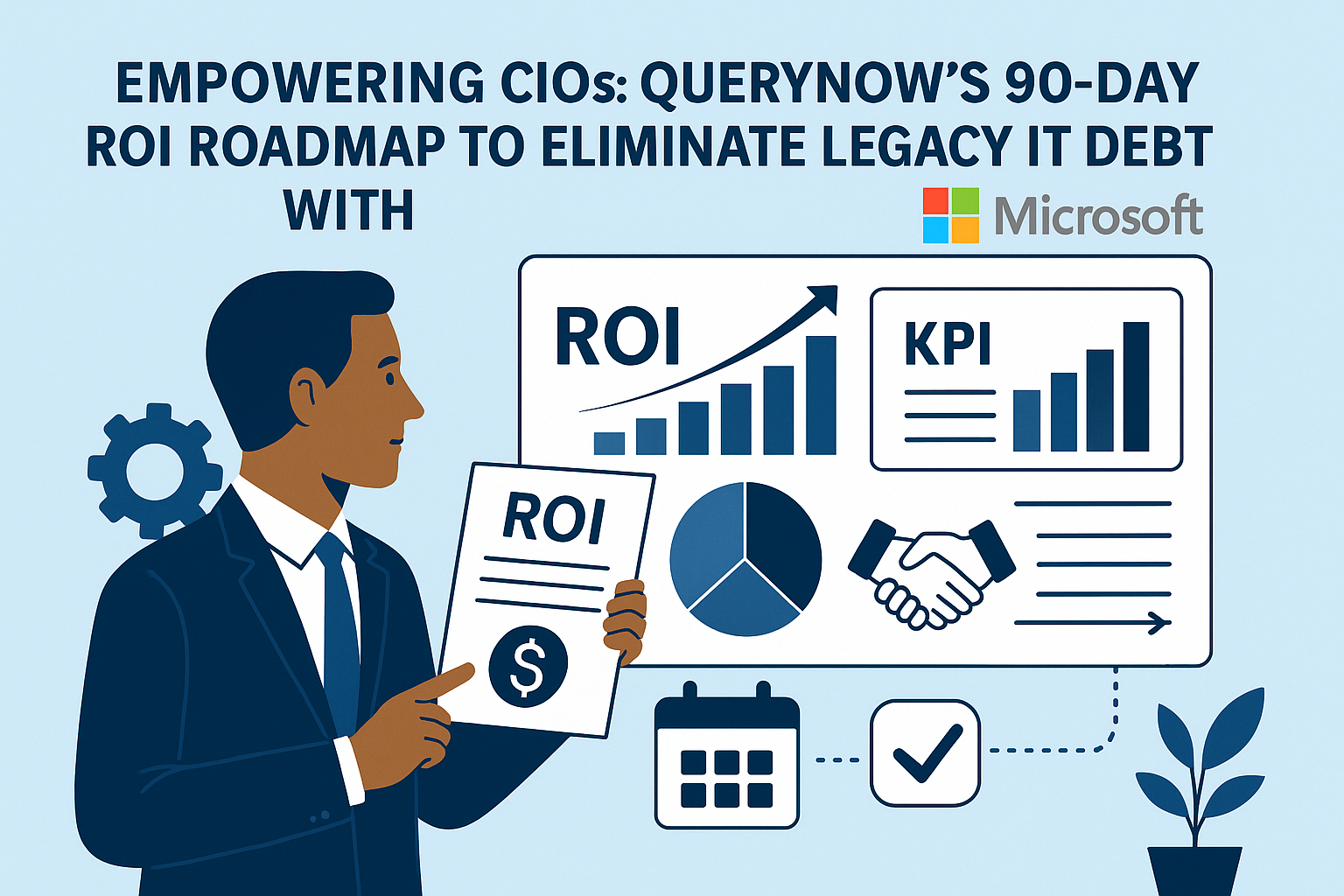
The CIO's Legacy IT Debt Dilemma
Every CIO knows the problem. Legacy systems consume 60-80% of IT budgets on maintenance while delivering diminishing business value. Technical debt accumulates. Security vulnerabilities multiply. Business agility suffers. Yet securing funding for modernization is nearly impossible.
CFOs demand clear ROI. Business leaders resist disruption to working systems. Boards question why IT cannot simply "fix" problems incrementally. Previous modernization attempts failed or ran over budget, creating organizational skepticism about large transformation projects.
CIOs are trapped: unable to maintain the status quo but unable to secure resources for change.
Why Traditional Business Cases Fail
Most legacy modernization business cases fail to secure funding because they rely on arguments that executives find unconvincing:
"Technical Debt" Arguments: IT teams explain technical debt, architecture limitations, and technology obsolescence. Executives hear: "We want to rebuild things because programmers prefer newer technology." Technical arguments resonate with IT but rarely with business stakeholders.
Vague Benefits: Business cases promise "improved agility," "better user experience," and "future-proofing"—benefits that are real but difficult to quantify and impossible to hold vendors accountable for delivering.
Large Upfront Investment: Traditional modernization requires multi-million dollar investments over 12-18 months before delivering any value. CFOs see huge risk for uncertain returns.
Vendor Risk: Organizations pay vendors regardless of whether modernization actually delivers promised benefits. Vendors have incentives to extend projects, not to deliver rapid ROI.
These weaknesses doom business cases before they reach board approval.
QueryNow's 90-Day ROI Roadmap Approach
Our methodology addresses each weakness in traditional business cases, creating compelling narratives that secure executive approval and board funding.
Phase 1: Current State Assessment and Cost Analysis (Weeks 1-2)
We begin with comprehensive assessment of legacy IT costs—not just obvious expenses but hidden costs executives do not see:
Direct Maintenance Costs: Vendor licenses, support contracts, infrastructure, and IT staff time dedicated to keeping legacy systems running.
Opportunity Costs: Business initiatives delayed or impossible due to legacy system limitations. Revenue lost to more agile competitors. Customer experience gaps created by outdated systems.
Risk Costs: Security vulnerabilities, compliance gaps, disaster recovery weaknesses, and key person dependencies. What would a major security breach cost? What happens when the last COBOL developer retires?
Hidden Inefficiency Costs: Manual workarounds, duplicate data entry, slow processes, and errors from system limitations—costs buried in business operations rather than IT budgets.
This analysis reveals the true cost of legacy systems, typically 2-3x what appears in IT budgets. Suddenly, modernization investment looks smaller relative to actual costs being incurred.
Phase 2: Future State Architecture and Benefits Modeling (Weeks 3-4)
We design target architecture using Microsoft cloud and modern development platforms, then model specific, measurable benefits:
Cost Reduction: Infrastructure consolidation through cloud migration, license optimization through modern licensing models, automation of manual processes, and reduced maintenance burden.
Revenue Enablement: New products or features impossible with legacy systems, faster time-to-market for competitive advantages, improved customer experiences driving retention and acquisition, and expanded market reach through digital channels.
Risk Mitigation: Elimination of security vulnerabilities, achievement of compliance requirements, reduction of key person dependencies, and improved disaster recovery capabilities.
Each benefit is quantified in financial terms with conservative, moderate, and optimistic scenarios. Executives see concrete numbers, not vague promises.
Phase 3: Phased Implementation Roadmap (Weeks 5-6)
Rather than big-bang transformation, we design phased approach delivering value incrementally:
Quick Wins (Months 1-3): High-value, low-risk improvements delivering immediate ROI. These early wins fund subsequent phases and build organizational confidence.
Foundation Building (Months 4-6): Core infrastructure and architecture modernization enabling future capabilities. Benefits begin accruing as workloads migrate to modern platforms.
Capability Expansion (Months 7-12): Advanced features and optimizations impossible with legacy systems. Business transformation accelerates as modern capabilities become available.
Continuous Improvement (Ongoing): Iterative enhancement and expansion based on business priorities and changing needs.
This phased approach reduces risk, accelerates time-to-value, and enables course correction based on actual results.
Phase 4: ROI Dashboard and Governance Framework (Weeks 7-8)
We design executive dashboard tracking actual ROI against projections in real-time. Metrics include:
Cost Metrics: Infrastructure costs, license costs, maintenance hours, and incident volumes—all trending down as modernization progresses.
Performance Metrics: System availability, response times, deployment frequency, and change success rates—all improving as modern architecture takes effect.
Business Metrics: Revenue from new capabilities, customer satisfaction scores, time-to-market for new features, and process efficiency gains—quantifying business value delivery.
Governance framework ensures accountability. Vendors are measured against metrics. Payments can be tied to achievement of milestones or even ROI delivery.
Phase 5: Risk-Aligned Engagement Model (Weeks 9-12)
Traditional vendors want upfront payment regardless of results. We structure engagements aligning vendor incentives with client success:
Pay-for-Results Pricing: Significant portion of fees tied to achievement of ROI targets. If modernization delivers projected savings and revenue, vendors are well compensated. If not, client investment is protected.
Milestone-Based Payments: Rather than time and materials, payments tied to delivery of working capabilities and achievement of success criteria.
Risk Sharing: We have skin in the game, creating alignment impossible with traditional vendor relationships.
This approach dramatically reduces client risk while ensuring vendor commitment to real business outcomes.
Case Study: Manufacturing Company Legacy Modernization
A mid-market manufacturer faced classic legacy challenges: 25-year-old ERP system, custom integrations impossible to maintain, $4M annual maintenance costs, and inability to implement e-commerce due to system limitations.
Previous modernization business case was rejected due to $12M cost and 18-month timeline with unclear benefits.
Using our 90-day roadmap approach:
Weeks 1-2: Assessment revealed $4M direct maintenance costs but $8M total costs including opportunity costs, manual workarounds, and delayed initiatives. True cost of legacy: $12M annually.
Weeks 3-4: Target architecture using Dynamics 365 and Azure would cost $6M annually, saving $6M. Additionally, e-commerce capabilities would generate $10M additional revenue annually.
Weeks 5-6: Phased roadmap started with e-commerce deployment (delivering revenue immediately) before tackling ERP modernization. ROI positive within 6 months.
Weeks 7-12: Executive dashboard and risk-aligned contract gave CFO confidence. Board approved funding.
Implementation delivered projected ROI. E-commerce launched in 4 months generating revenue covering modernization costs. Full transformation completed in 14 months under budget.
Why This Approach Works
Speaks Executive Language: Financial metrics and business outcomes rather than technical jargon. CFOs and boards understand ROI, risk, and accountability.
Addresses Real Concerns: Risk is mitigated through phasing, proof points, and performance-based contracts. Large upfront bets are replaced with evidence-based progression.
Creates Accountability: Clear metrics and vendor risk-sharing ensure all parties are motivated to deliver real results rather than just complete projects.
Delivers Quick Wins: Early value delivery builds confidence and funds subsequent phases rather than requiring full investment upfront with distant payback.
The CIO's Modernization Toolkit
Successful CIOs using this approach gain more than just approved modernization projects. They build systematic capability for driving technology change:
Executive Communication Framework: Methodology for translating technology initiatives into business cases that resonate with non-technical stakeholders.
Vendor Management Model: Performance-based contracting approach aligning vendor incentives with business outcomes.
Value Tracking System: Dashboards and metrics proving IT's contribution to business results rather than just completing projects.
Organizational Confidence: Track record of delivering promised results builds trust enabling future transformation initiatives.
Getting Started
If you are a CIO struggling to secure funding for necessary legacy modernization—or if previous modernization business cases have been rejected—the 90-day ROI roadmap provides a proven alternative approach.
The methodology works because it addresses the real reasons executives reject modernization proposals: unclear benefits, high risk, vendor accountability, and uncertain timeline to value.
Ready to build a compelling case for legacy modernization? Contact QueryNow for a legacy modernization ROI assessment. We will evaluate your legacy environment, quantify true costs, model modernization benefits, design phased roadmap, and develop executive presentation that secures funding for necessary transformation.


